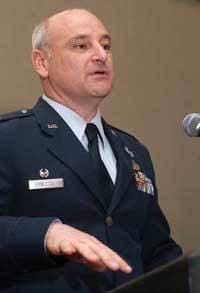By Courtney E. Howard
BOSTON - A top U.S. Air Force expert stressed the importance of the U.S. military’s move from a weapons-centric to a network-centric model of future warfare in a keynote address he delivered at the 2006 Military Technologies Conference (MTC) March 14 in Boston.
In the presentation titled “The Challenges of Achieving a Net-Centric Environment,” Col. David W. Madden, commander of the Enterprise Integration Systems Group of the Electronic Systems Center at Hanscom Air Force Base, Mass., outlined his role in making network-centric operations a reality.
The Military Technologies Conference was presented by Military & Aerospace Electronics magazine and cosponsors the National Military Intelligence Association, Defense Systems, Government Corporate News, and Washington Technology.
The transformation to net-centricity, as Madden referred to it, involves integrating once-disparate systems across an enterprise. Each branch of the military has its own system, but these systems cannot network together.
“We carry thousands of pounds of military systems onto the battlefield because they were all built by different guys and they don’t talk to each other,” he noted, stressing the importance of sharing knowledge, rather than reinventing it. “In a federated environment, everyone has the same situational awareness.”
By connecting systems, networks are established and data sharing enabled. “Systems have to correlate and talk to each other,” said Madden, “so they have to be connected.” The key is to fuse and use all the data available, such as from air, land, and sea resources; synthesize it in real time; and deliver only the information needed.
Madden discussed the need for a paradigm shift, from overloading an individual in the field with information to providing only that which is necessary to get the job done. “That’s what it’s all about-getting the right information to the right place at the right time.”
In this scenario and virtually all other military applications, such improved information sharing could contribute to greater mission effectiveness. At the same time, a collaborative environment can lend to a reduction in costs and errors, as well as an increase in efficiency.
Yet, the free exchange of information described here is not without its risks. As an example, in an open environment, more personnel would be privy to specifics about a mission or event-opening the door for more people to become involved in a particular action. Conversely, the automated exchange of data could lend to scenarios in which junior-level men are passing information to strike aircraft, potentially excluding a key decision maker who better understands the politics or sensitivity of a certain situation.
As these examples illustrate, other processes and operations must be adapted. “It’s not about doing the same thing more efficiently,” Madden told conference attendees. Rather, he said, it’s about making the most of current capabilities.
In concluding his talk, Madden conveyed a desire to work with the industry to “get a feel of where technology is going,” and to “build a technology roadmap for net-centric operations in the future.” A need exists, as he sees it, not for simply another new tool or system, but for solutions capable of sharing information and talking to each other.




